The original text is from Galaxy
Translation|Odaily Planet Daily Golem (@web3golem)_
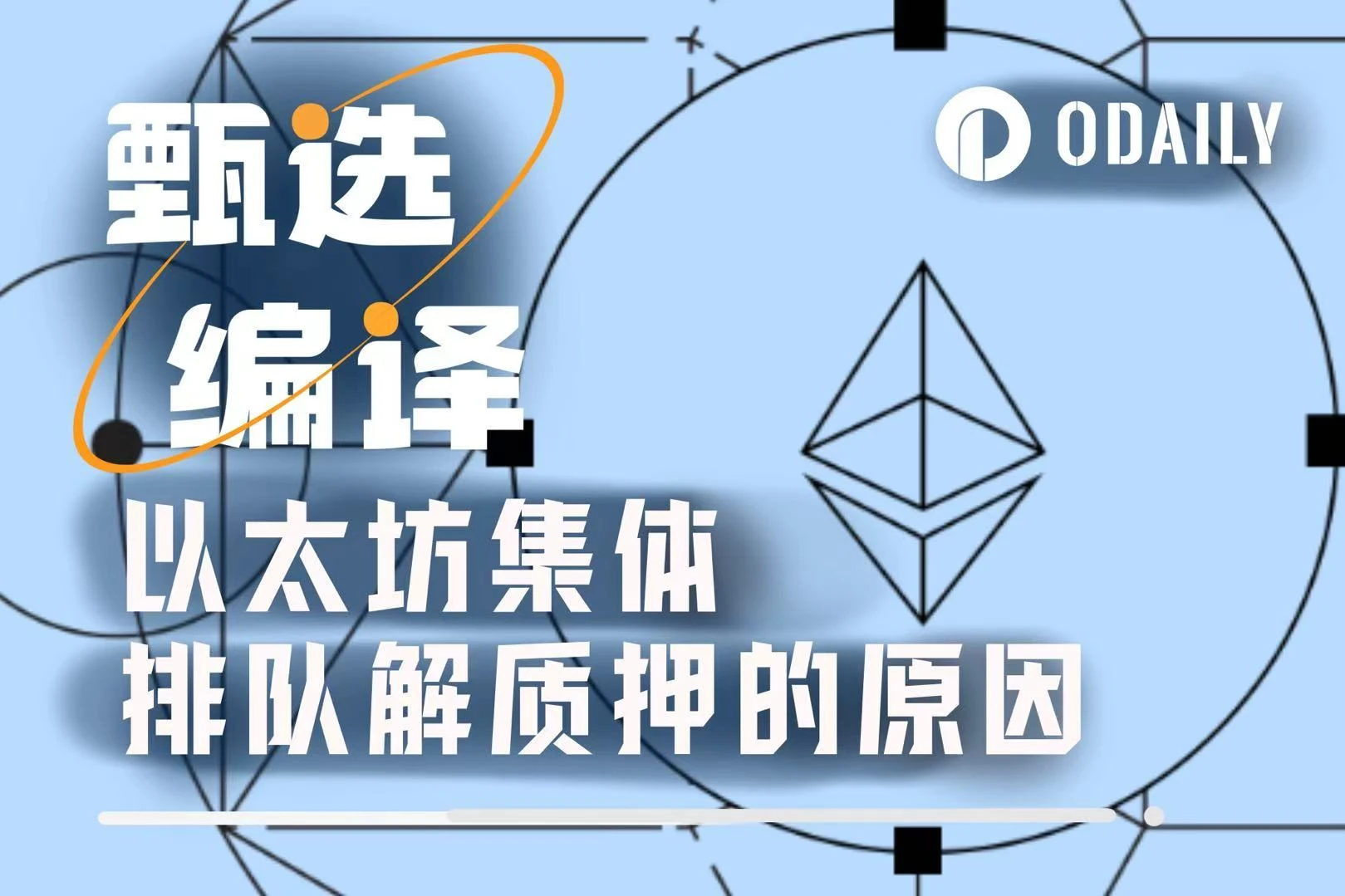
Starting from July 16, the number of ETH unstaking requests surged dramatically, with the number of validators exiting the queue skyrocketing from 1,920 to over 475,000 by July 22, and the waiting time increasing from less than an hour to over eight days. While the increase in unstaking activity was expected due to ETH's recent strong price performance and adjustments to validator staking requirements from the recent ETH Pectra upgrade, the sharp rise was primarily driven by the surge in ETH lending rates that began on July 16. The spike in rates triggered widespread liquidations of ETH circular lending strategies, which in turn exacerbated the decoupling pressure on ETH-based liquid staking and restaking tokens (LST and LRT).
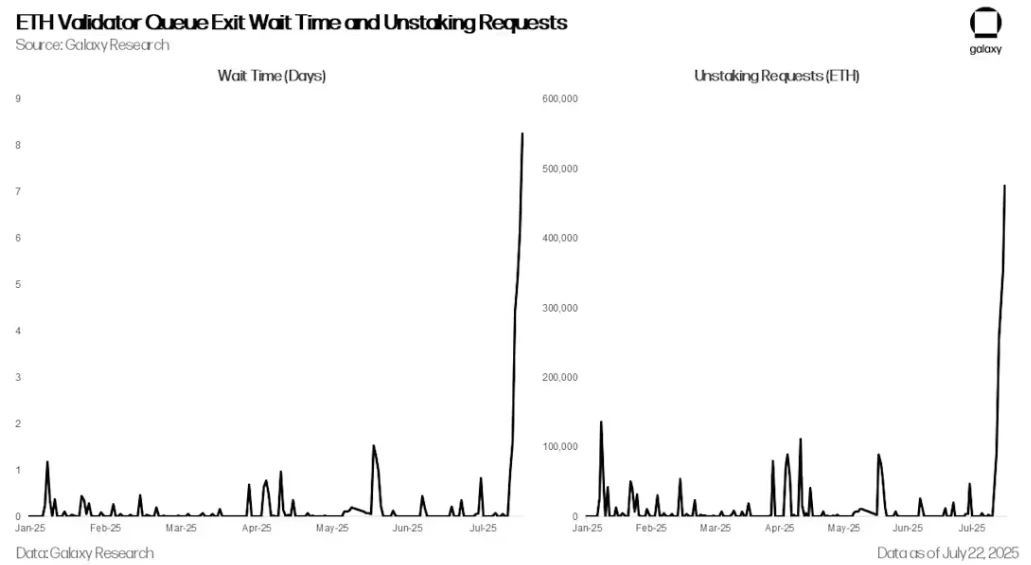
ETH validator queue exit waiting time and unstaking requests
Ethereum Staking Queue
The Ethereum staking exit queue is a built-in mechanism designed to manage the orderly withdrawal of staked funds by validators from the network. To maintain network stability and prevent large-scale validator exits from jeopardizing consensus, Ethereum limits the number of validators that can exit in each epoch. This limit, known as the churn limit, varies with the total number of active validators, allowing approximately 8 to 10 validators to exit each epoch (about every 6.4 minutes). When validators initiate a voluntary exit, they enter the queue and must wait their turn to be processed. After exiting, they must wait a period (about 27 hours) to withdraw their funds. During periods of high exit demand, the queue can become severely congested, leading to waiting times of several days or even weeks.
This week is not the first time Ethereum has experienced a backlog in unstaking. In January 2024, due to the restructuring of the bankrupt cryptocurrency lending institution Celsius, which needed to withdraw 550,000 ETH, the waiting time in the queue reached six days.
ETH Circular Lending Strategy Fails Due to Surge in Lending Rates
Starting from July 14, the ETH lending rates on the Aave DeFi protocol began to surge periodically. While lending rates typically range from 2% to 3%, on July 16, 18, and 21, the rate spiked to 18%. The dramatic fluctuations were caused by a sharp decrease in the supply of ETH on the Aave platform, stemming from a wallet associated with the HTX exchange making large withdrawals from the platform. Since June 18, this wallet has withdrawn over 167,000 ETH. The sudden decrease in ETH deposits put pressure on users running ETH circular lending strategies on Aave and led to a surge in some redemption requests.
Circular lending strategies are widely used by cryptocurrency traders to enhance ETH staking yields. A common form involves users depositing liquid staking tokens (LST) or liquid restaking tokens (LRT) as collateral on platforms like Aave, borrowing ETH, and then exchanging it back to LST and redepositing, repeating this process to accumulate leveraged exposure. When staking yields exceed ETH lending rates, the strategy becomes profitable, allowing users to earn the spread. This strategy can be executed manually or through automated vaults provided by protocols like EtherFi and Instadapp.
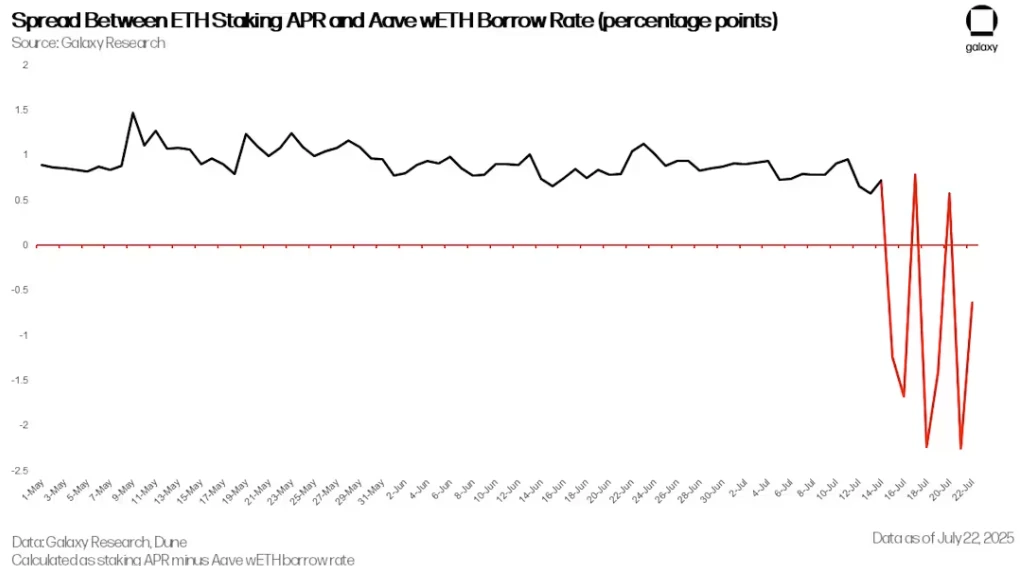
The spread (in percentage points) between ETH staking annual yield and Aave wETH lending rate
However, following the ETH supply tightening that began on July 16, the spread between staking yields and ETH borrowing costs turned negative. By July 21, the spread had dropped to -2.25%, rendering the strategy unprofitable. This triggered a collective liquidation among traders, prompting users to withdraw their provided ETH, repay loans, and gradually reduce their position leverage. As many traders used LST or LRT as collateral, they needed to convert these assets back to ETH or unstake them. This further pressured the LST/LRT secondary market and the Ethereum validator exit queue.
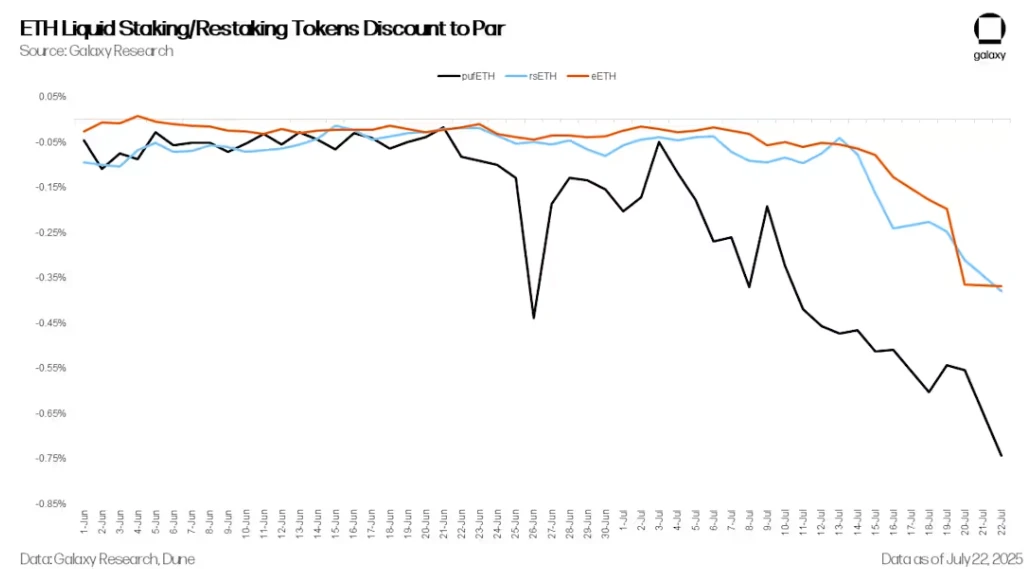
LST and LRT trading below par value
As lending rates climbed, LST and LRT began to further decouple from ETH. LST/LRTS typically trade at slightly below the price of ETH to compensate for redemption delays caused by the Ethereum exit queue, limited DEX liquidity, and protocol-specific risks (such as penalties or smart contract risks). During forced deleveraging or redemption periods, this selling pressure can push LST/LRT prices further below par value. Additionally, automated circular lending vaults respond differently to disruptions. Some vaults choose to unstake, while others sell directly on the secondary market. For example, as of today, EtherFi's Liquid strategy has approximately 20,000 ETH in the Ethereum exit queue.
Further exacerbating the queue congestion is that some market participants have begun to exploit the LST/LRT decoupling for arbitrage. By purchasing LST/LRT at a discount on the secondary market and redeeming the collateral for its full value in ETH, they can profit from the price difference between the two. This has led to a surge in the number of ETH exit queue requests.
Increased Demand for Staking and Becoming Validators
The surge in redemption requests for collateral has been offset by a spike in demand for new collateral. Since June, the length of ETH collateral requests and the queue for becoming a validator has reached its highest level since April 2024.
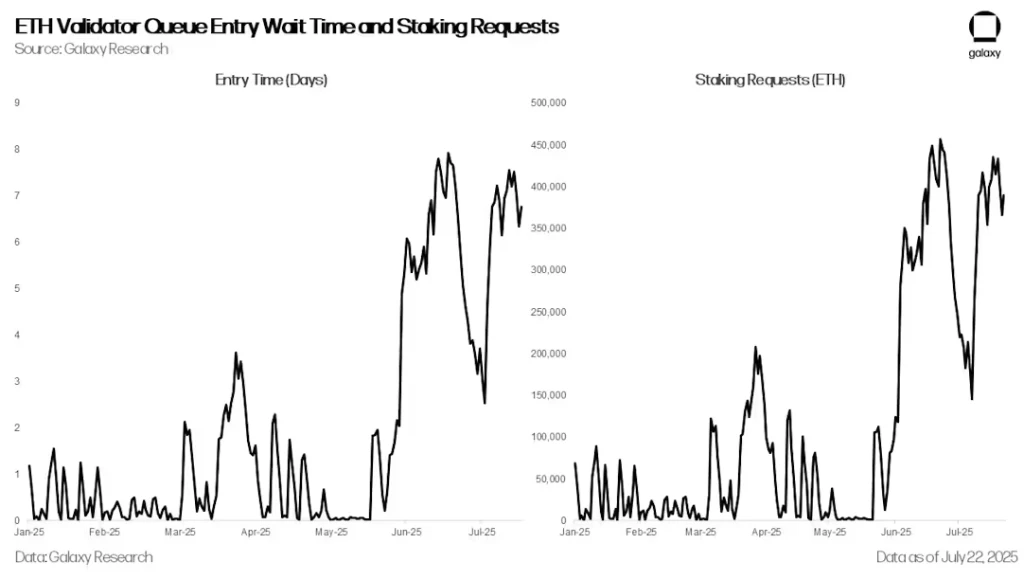
ETH validator queue waiting time and staking requests
This is due to ETH's recent performance exceeding that of Bitcoin, as well as the establishment of several digital asset financial companies (DATCO), which have purchased over $2.5 billion worth of ETH in recent months, sparking enthusiasm for ETH.
Outlook
While the overall data on unstaked ETH may initially suggest a wave of profit-taking, a closer look reveals that most of the activity is driven by volatility in the ETH lending market and the significant rise in lending rates that began on July 16. At the same time, new staking demand remains strong, nearly offsetting the ongoing withdrawal volume, so investors need not panic.
Despite the increase in demand, the ETH staking architecture continues to operate as expected. While some may complain about the significantly increased waiting times, this is a feature of the network rather than a flaw. It is designed to limit the speed at which validators can enter or exit, thereby protecting the stability and security of Ethereum's proof-of-stake (PoS) consensus mechanism.
However, this event highlights the ongoing fragility of the ETH liquid staking and restaking ecosystem. These assets remain sensitive to leveraged strategies and are prone to pressure under extreme market conditions. The widespread impact of LST/LRT decoupling and redemption delays reinforces the importance of considering term risks and liquidity bottlenecks.
Looking ahead, protocols that rely solely on Ethereum's native exit mechanism may face stricter scrutiny. We anticipate growing interest in solutions that enhance redemption flexibility, such as peer-to-peer exit markets, improved LST/LRT automated market makers (AMM), and protocol-native liquidity vaults aimed at alleviating exit queue congestion and smoothing capital flows.
Related Reading
The $1.9 billion ETH unstaking wave: Profit-taking or a new starting point for the ecosystem?
免责声明:本文章仅代表作者个人观点,不代表本平台的立场和观点。本文章仅供信息分享,不构成对任何人的任何投资建议。用户与作者之间的任何争议,与本平台无关。如网页中刊载的文章或图片涉及侵权,请提供相关的权利证明和身份证明发送邮件到support@aicoin.com,本平台相关工作人员将会进行核查。




